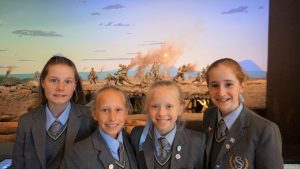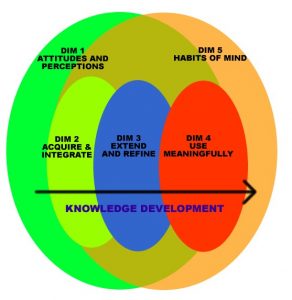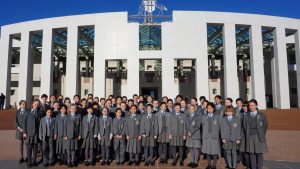What Are Higher-Order Thinking Skills and Why Are They So Important?
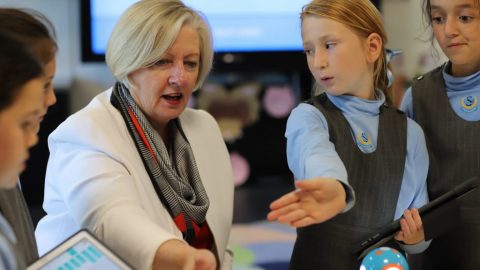
The focus of education today is to develop students who not only learn knowledge and skills but can apply what they have learnt purposely and meaningfully to address a range of needs, whether they be problem solving, making decisions, inventing, investigating, and so on. This focus is reflected in the shift in assessment in the Australian Curriculum from what students can recall to what students can demonstrate or apply with their learning.
Robert Marzano, an educational researcher, believes that there are five types of thinking or ‘dimensions of learning’ (Marzano & Pickering, 2009) that are essential to successful learning:
- Dimension 1: Attitudes and Perceptions – affecting students’ abilities to learn.
- Dimension 2: Acquire and Integrate Knowledge – how students take on new learning (knowledge and skills) and how these link to prior knowledge.
- Dimension 3: Extend and Refine – how students develop in-depth understanding.
- Dimension 4: Using Knowledge Meaningfully – using knowledge to perform meaningful tasks.
- Dimension 5: Habits of Mind – thinking routines that promote critical, creative and self-regulated thinking.
It is in Dimensions 3 and 4 that we see higher-order thinking skills being applied. Dimension 3 looks at students learning the eight complex reasoning processes that deepen learning:
- Comparing
- Classifying
- Abstracting
- Inductive reasoning
- Deductive reasoning
- Constructing support
- Analysing errors
- Analysing perspectives.
Once mastered, students have the skills and can apply combinations of those listed above to the following reasoning processes:
- Decision making
- Problem solving
- Invention
- Experimental inquiry
- Investigations
- System analysis.
An example of the above would be the process a person goes through when voting. To start with, a person would gather all of the information they could about the candidates. Once collected, they would start a comparison, noting their similarities and differences or they might have a criteria for classifying candidates by their policies. They then might analyse each candidate’s perspective and listen to the perspectives of others on what they like or dislike about the candidates and why. They could then use their inductive or deductive reasoning to make generalisations or draw conclusions.
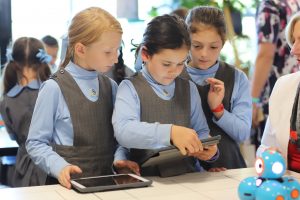
Teaching higher-order thinking skills enables students to extend and refine their knowledge and apply it meaningfully.
When applying the in-depth understanding gained in Dimension 3, they would then be able to meaningfully use the Dimension 4 reasoning process of decision making.
Teaching higher-order thinking skills enables students to extend and refine their knowledge and apply it meaningfully – making them better equipped with a range of thinking strategies and routines for life. Teaching them the tools and how to think in meaningful ways produces far better students than ones that can just recall information.
Ms Karen McArdle, Head of Junior School
Reference:
- Marzano, R., & Pickering, D. (2009). Dimensions of Learning Teacher’s Manual 2ndEd. Alexandria VA: ASCD.
Did You Know That Your Old Mobile Phones Can Help Protect Endangered Chimpanzees?
The Barbreck Environment Committee invites you to take part in our Mobile Phone Recycling Campaign for the remainder of 2019. We are collecting old mobile phones through Jane Goodall’s Roots & Shoots organisation. The program is committed to raising awareness and educating the community on why it is important to recycle.
Our aim is to reduce the impact of mining on areas inhabited by great apes by removing mobile phones from the waste stream by re-marketing them for reuse or breaking them down for recycling. Phone refurbishment helps to reduce the demand for new coltan which is mined from chimpanzee habitat. Phones that cannot be reused are dismantled and recycled.
When you donate your old phone, the Roots & Shoots mobile phone recycling partners donate money on our behalf. This money then goes towards conservation programs in Africa.
Please drop off your old phones in one of our mobile phone recycling boxes. One can be found at the Junior School Reception and one is located outside of the 4S classroom.
Thank you for your support in making a difference!

Barbreck Environment Committee
Year 6 Canberra Study tour
Early in Term 3, the Year 6 students travelled to Canberra to undertake a study tour of Australia’s capital city. The study tour was based around an Australian Government unit of learning and consolidated and reinforced the learning they had undertaken in classroom lessons.
Some of the activities they participated in were role-plays at both the Museum of Democracy and Parliament House, as well as touring Government House at Yarralumla. Visiting The Australian War Memorial gave students the opportunity to learn and reflect upon some of the stories of service men and women and the sacrifices they made during conflicts.
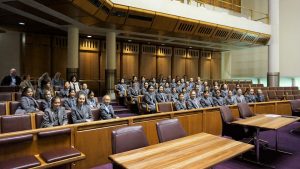
“In Canberra, I learnt about how we do not choose our Prime Minister. I also learnt how bills are passed.” – Sophie Powell.
“Before I went to Canberra, I used to think that there were only two political parties, the Liberal Party and the Labor Party, but after the amazing trip, I learnt that there are many other political parties. I also learnt more about the role all of the parties play in the Australian government.” – Xiuqi (Anna) Wang.
“When we visited Government House, I learnt about the Governor-General and the roles he has. The Governor-General represents the Queen and he is the one who can sign off on laws.” – Ella Derbyshire.
“I learnt about all the roles and positions in the High Court of Australia and how there was a competition to design Canberra and there were entries from all across the world.” – Amelie Arnold.
